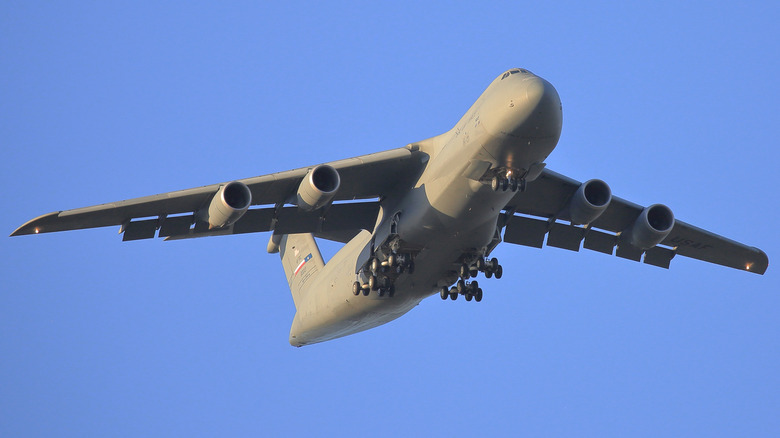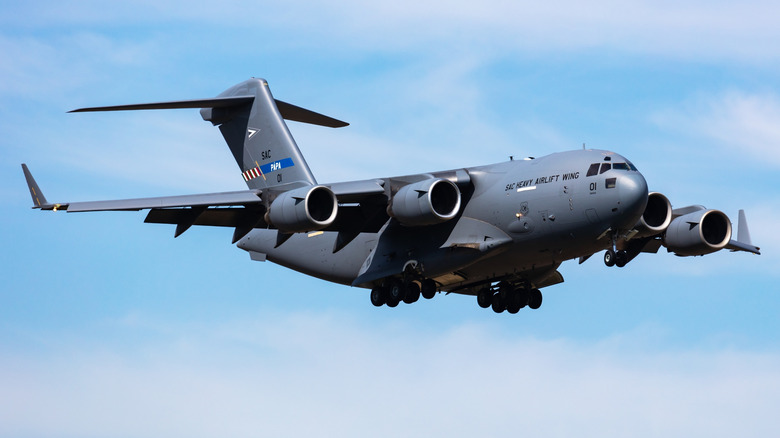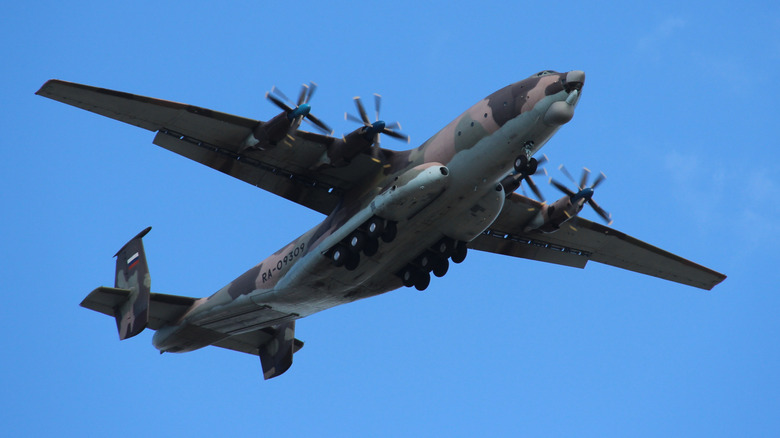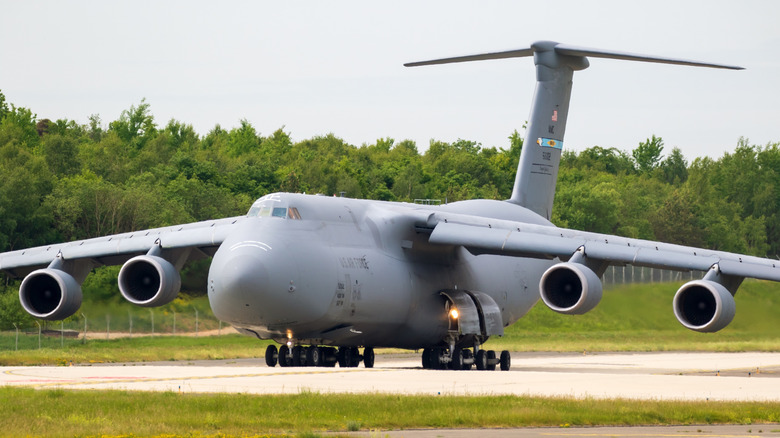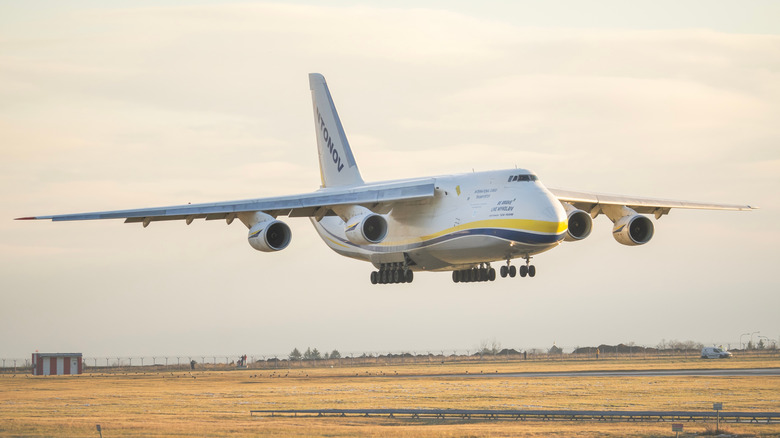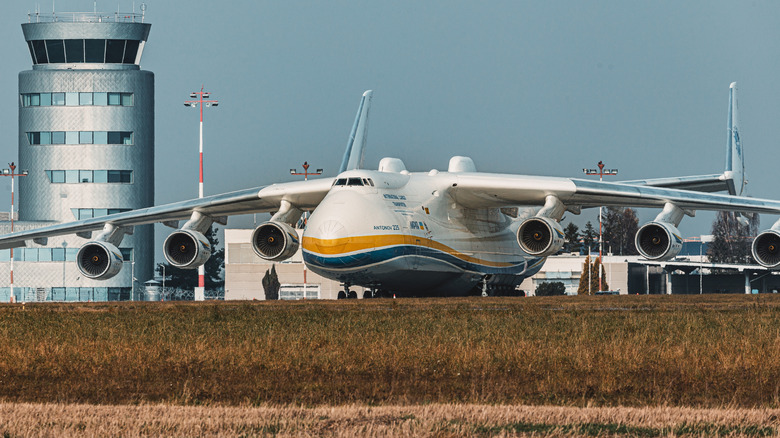The World's 5 Most Powerful Military Transport Aircraft
When most people think about aircraft operated by the U.S. Air Force, they likely consider fighter jets like the F-35A Lightning II or bombers like the B-2 Spirit. These are the aircraft that get the most attention, and they provide a great deal of mission functionality to the Air Force, but the service is more than its attack aircraft. Some of the Air Force's most important aircraft aren't meant for combat at all — these are the incredibly important strategic airlift planes, designed to move incredibly heavy cargo across the globe.
Of course, the U.S. Air Force isn't the only military on the planet that employs such aircraft, as most militaries have something similar. While it's certainly important to deliver bombs on target and destroy critical infrastructure, if you don't move troops, cargo, vehicles, and everything else, there's no way to capture and retain territory. During WWII and before, most of these items were brought by naval vessels, but these days, aircraft are much faster.
Still, they need to carry a ton of weight — several tons, in fact, so they need to be massive. There's no shortage of large strategic airlift aircraft around the world, but there are some that are so large they defy reason. These are the huge planes that boast more engines than makes sense, requiring literal tons of fuel for each flight hour. While there are dozens of these types of military transport aircraft, the five detailed here are the biggest of them all, and it's unlikely anyone will build them larger than these beasts.
Boeing C-17 Globemaster III
The C-17 Globemaster III is one of the primary workhorse military transport aircraft operated by the U.S. Air Force. It first entered service in 1995; since then, 279 were built before production shut down in 2015. It's most often used for tactical and strategic airlift operations of troops and cargo anywhere in the world, and has gone through several block upgrades throughout its service history. The final upgraded model, Block 21, incorporated Automatic Dependent Surveillance-Broadcast Out (ADS-B OUT) communications, Identification of Friend or Foe (IFF) functionality, and various upgrades to communication and flight management.
The aircraft boasts a wingspan of nearly 170 feet and a length of 174 feet. It stands 55 feet 1 inch high, has a cargo compartment measuring 88 feet long by 18 feet wide, and 12 feet 4 inches high. That enables the C-17 to carry up to 102 troops, 36 litters with 54 ambulatory patients and medical personnel, or 170,900 lbs. (85.45 tons) of cargo in 18 pallet positions.
That's a great deal of weight, and all told, the C-17 has a maximum takeoff weight of 585,000 lbs. (292.5 tons). The C-17 is outfitted with four Pratt & Whitney F117-PW-100 turbofan engines to move that much mass around. These provide a combined 161,760 pounds of thrust, enabling the massive aircraft to fly Mach 0.74 (567.8 mph). It has a cruise altitude of 45,000 feet and a range of 2,762 miles, though this extends to an unlimited range via aerial refueling.
Antonov An-22 Antei
The Antonov An-22 Antei is a heavy strategic military transport aircraft developed for the Soviet Union in the 1960s. It first flew in 1965, and approximately 70 were ever constructed. Despite its age, the An-22 a few dozen continue flying in service of the Russian Aerospace Forces. Most notably, the An-22 is a turboprop aircraft, and it's the largest propeller-driven aircraft ever built. It's powered by four Samara-Kusnetsov NK-12MA engines, producing a combined 60,000 horsepower.
When the An-22 was built, it was the largest airplane ever constructed, though it has since lost that distinction. In terms of size, the An-22 is a beast, measuring 190 feet long with a wingspan of 211 feet 3.5 inches. The aircraft's height measures just over 41 feet, and it has an empty weight of 251,327 lbs. (125.7 tons). Its maximum takeoff weight is 551,156 lbs. (275.6 tons), so despite its turboprop engines, it carried a heavy load.
Turboprops are typically more fuel-efficient and cheaper to operate, so it's not entirely unusual for a large transport aircraft to use them — the C-130 Hercules is also a four-engine turboprop transport plane. The aircraft was designed for both civilian and military transport, but it's primarily used for the latter. It can carry a payload of 176,370 lbs. (88.2 tons), a flight crew of six, and up to 29 passengers. In terms of speed, it can fly through the skies at Mach 0.6 (460.4 mph) with a maximum range of 3,107 miles when fully loaded.
Lockheed C-5M Super Galaxy
The C-5M Super Galaxy is the latest variant of the largest and only strategic airlifter operated by the U.S. Air Force. It first entered service in 1970, and 131 were built before construction ended in the 1980s. The C-5M is upgraded to 21st-century standards, ensuring the aging plane's service life extends beyond the 2020s. The massive transport aircraft features five sets of landing gear and 28 wheels, which are needed to hold the incredible weight of the fully loaded plane.
The C-5 Galaxy is a heavy plane with an impressive carrying capacity of 281,101 lbs. (140.6 tons). The C-5M's range without refueling is 5,525 miles, and it has a top speed of Mach 0.67 (518 mph). The plane's power plant consists of four F-138-GE100 General Electric engines, providing a combined thrust of 205,000 lbs. Regarding its size, the C-5M has a wingspan of 222 feet 9 inches and a length of 247 feet 10 inches.
Its height is 65 feet 1 inch, and it boasts a cargo compartment measuring 13 feet 6 inches high, 19 feet wide, and a length of 143 feet 9 inches, allowing for 36 pallet positions. The C-5M can be aerially refueled, but in December 2023, Airmen turned it around, making the aircraft into a "Huge floating gas station." This extended the plane's abilities by reverse-flowing fuel from the C-5M into a KC-10 Extender. While not its designed capability, this opens the door for more operability, thanks to the C-5M's onboard fuel capacity of 51,150 gallons.
Antonov An-124 Ruslan
The Antonov An-124 Ruslan is a former Soviet Union strategic airlifter designed in the 1980s. It first entered service in 1987, and before construction ended, 55 were built, with several continuing to operate. It remains the largest military transport aircraft in service as of 2025, and it earned that distinction through its massive carrying capacity. In addition to its flight crew of six, the aircraft can accommodate 88 passengers. When combined with this and the main cargo compartment's payload, it can carry a total of 330,695 lbs. (150 tons).
To move that much mass around, the An-124 features four ZMKB Progress (Lotarev) D18T turbofan engines capable of providing a combined thrust of 206,360 pounds. When filled to capacity, the An-124 has a maximum takeoff weight of 892,875 lbs. (446.4 tons), but despite this, it can cruise at speeds of Mach 0.7 (547.48 mph). The size of the aircraft is as massive as you'd think, measuring 226 feet 9 inches long, 68 feet 2 inches high, with a wingspan of 240 feet 6 inches.
Despite its size, pilots have described the An-124 as easy to handle and light on the controls, which is the opposite of what a layperson would think when seeing this beast on the runway. While the An-124 was built for the Soviet Air Forces, several of the aircraft have been used for commercial as well as humanitarian purposes. It remains the largest aircraft of its kind, and its ability to move 150 tons of cargo makes it ideal for a variety of missions and operations.
Antonov An-225 Mriya
The Antonov An-225 Mriya was a strategic airlift aircraft designed by the Soviet Union in the 1980s. Unfortunately, only one was ever built, and the An-225 no longer exists, having been destroyed by Russian Federation forces at the Battle of Antonov Airport in 2022. When it existed, it was the largest and heaviest aircraft ever built. Its features were all off-the-scale, including its maximum takeoff weight of 1.2+ million lbs. (617 tons). It was designed to transport objects by air that would otherwise be immovable, including the Buran spaceplane for the Soviet Space program.
To accommodate other large, heavy objects, the An-225 had a length of 275 feet and a height of almost 60 feet. Its wingspan was 290 feet. It was powered by six Progress D-18T turbofan engines, the same that power the An-124. These provided a combined thrust of 310,032 pounds, enabling the massive aircraft to reach a cruise speed of Mach 0.68 (528 mph), which is impressive, given its size. It had a range of 9,569 miles and a fuel capacity of 99,567 gallons.
The most incredible aspect of the An-225 is its maximum carrying capacity, which was 551,156 lbs. (275.6 tons), which means it could have carried the Antonov An-22 Antei at its maximum takeoff weight. Theoretically, it could have been attached to the top of the aircraft like the Soviet space shuttle. The An-225's stats alone make it an oddity among history's most interesting planes, and while it was destroyed, the An-225 held many impressive records for decades.
